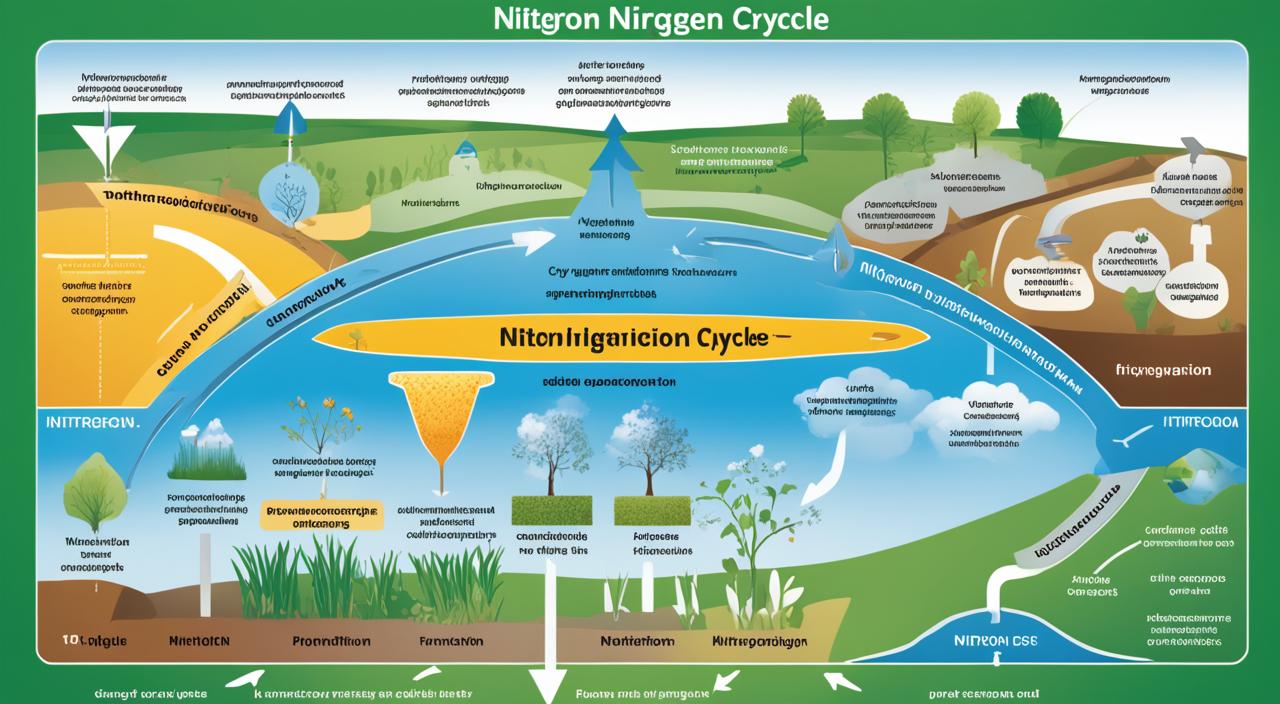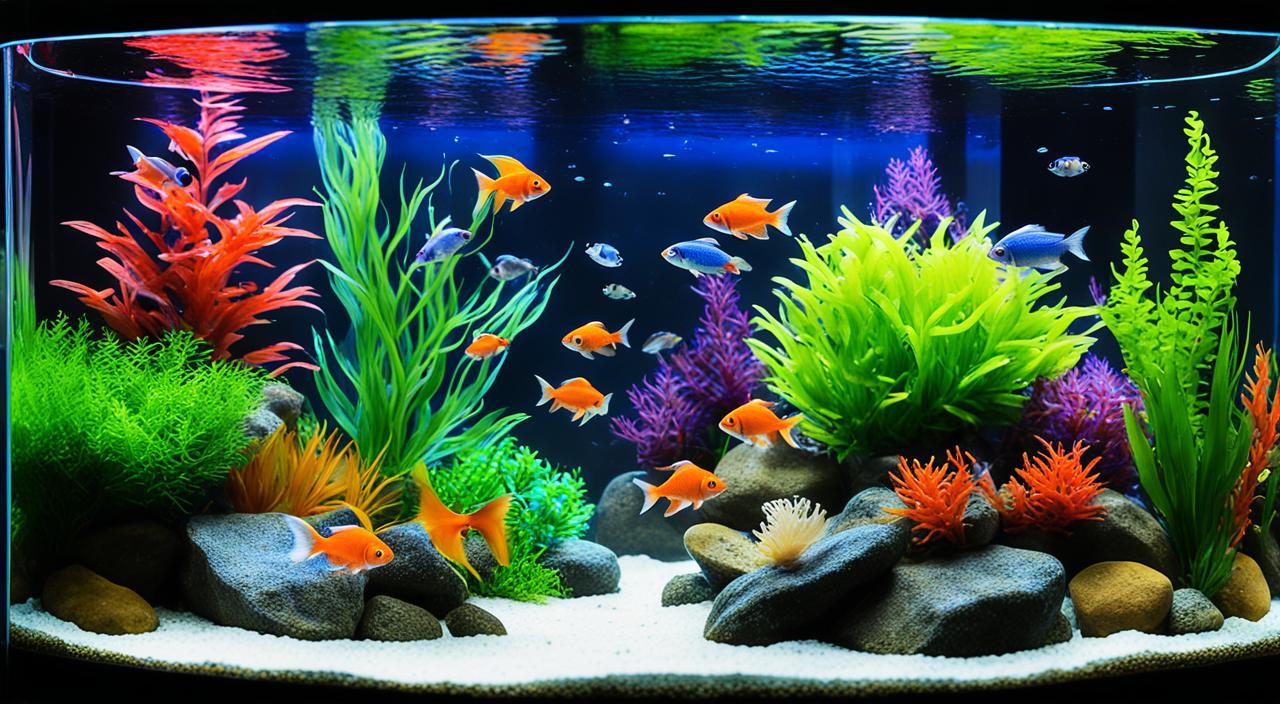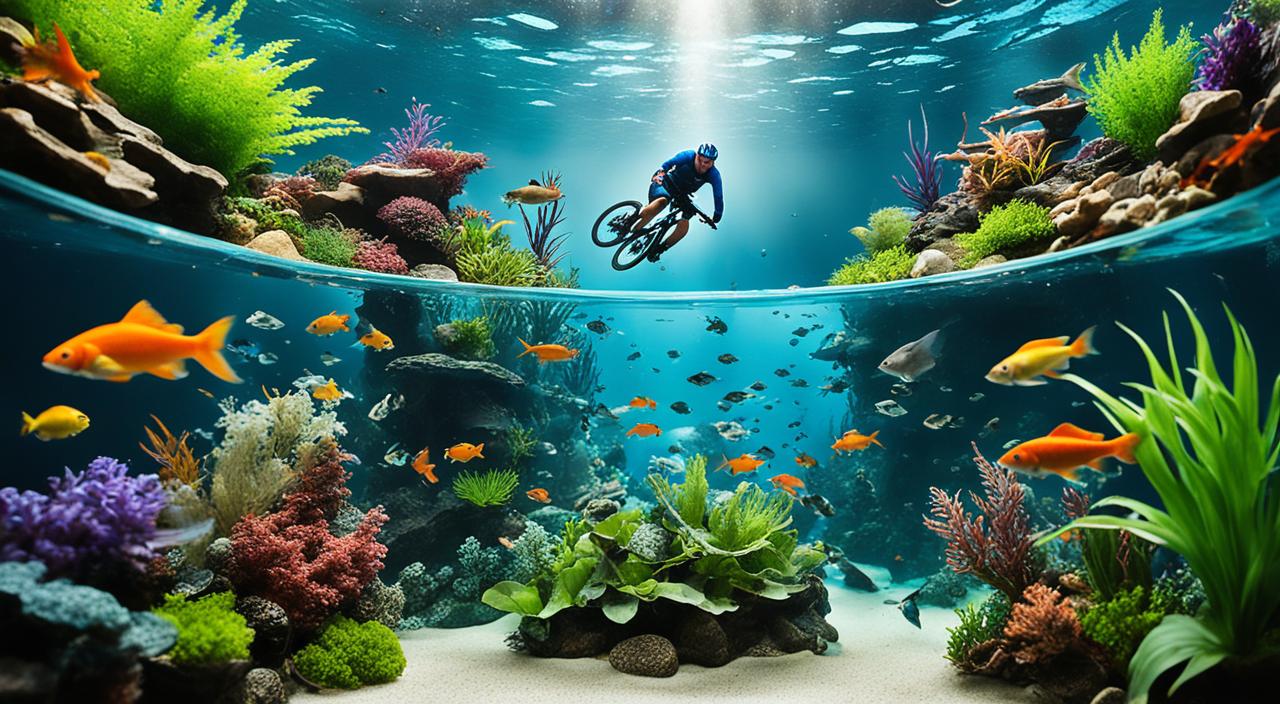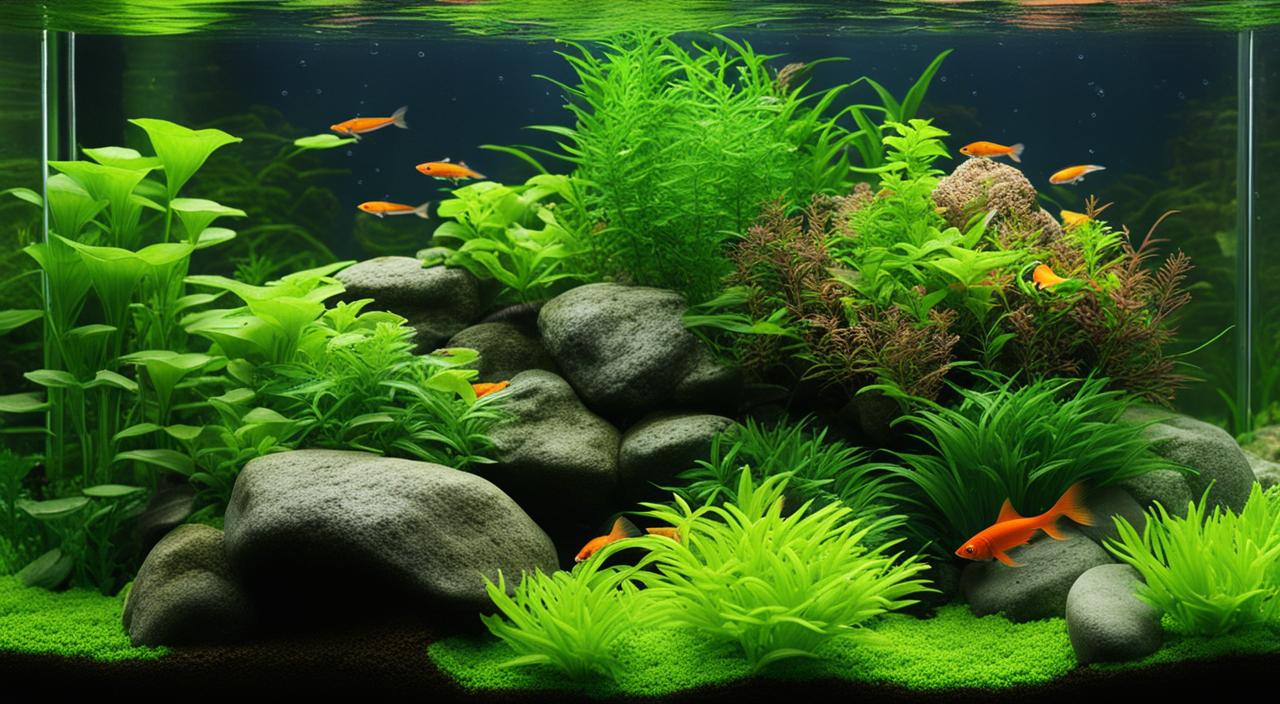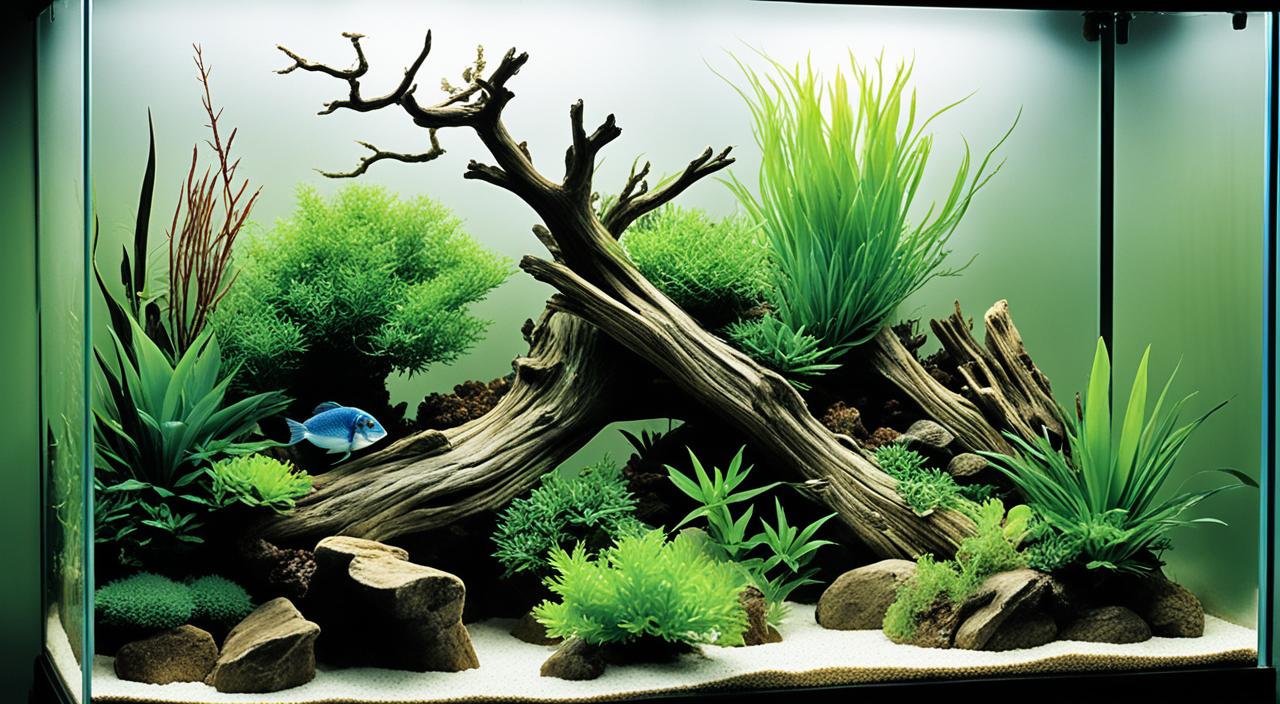The nitrogen cycle is an essential ecological process that occurs in ecosystems worldwide. It describes the conversion of nitrogen from one form to another, influencing the availability of this vital element for living organisms.
In this guide, I will explain the steps and processes involved in the nitrogen cycle, from nitrogen fixation to nitrification, denitrification, and ammonia oxidation. Understanding the nitrogen cycle is crucial for anyone interested in maintaining a healthy ecosystem, whether aquarium or natural.
Key Takeaways:
- The nitrogen cycle is a fundamental ecological process involving converting nitrogen from one form to another.
- The main steps in the nitrogen cycle are nitrogen fixation, nitrification, denitrification, and ammonia oxidation.
- Nitrogen fixation is the process through which atmospheric nitrogen is converted into a form that plants and other organisms use.
- Nitrification is the conversion of ammonia into nitrites and then into nitrates by beneficial bacteria.
- Denitrification is when nitrates are converted into atmospheric nitrogen, completing the cycle.
- Ammonia oxidation is the conversion of ammonia into nitrites by other groups of beneficial bacteria.
- The nitrogen cycle is essential for the health of ecosystems, including aquariums, by ensuring nitrogen availability for plants and organisms while maintaining a balance of nutrients.
The Nitrogen Cycle in Aquariums
In aquariums, the nitrogen cycle is a crucial process that ensures the health and well-being of the fish. Understanding how this cycle works is essential for maintaining a thriving aquatic environment.
The nitrogen cycle begins with fish waste, which produces ammonia. Ammonia is highly toxic to fish and can be harmful if not removed from the aquarium. Fortunately, beneficial bacteria play a vital role in the nitrogen cycle. They consume the ammonia and convert it into nitrites, which are somewhat toxic but less harmful than ammonia. Another group of beneficial bacteria then consume the nitrites and convert them into nitrates, the least toxic form of nitrogen compound.
It is essential to have a sufficient population of beneficial bacteria in the aquarium to consume these nitrogen compounds. Additionally, the presence of aquarium plants can also aid in the nitrogen cycle. Aquarium plants consume nitrates, helping to prevent their buildup to harmful levels. This symbiotic relationship between beneficial bacteria and plants protects the fish from the toxic effects of ammonia and nitrates.
If nitrates accumulate in the aquarium and reach high levels, it is crucial to take action. One way to reduce nitrates is through regular water changes, which dilute the concentration of nitrates in the water. Another effective method is to incorporate more aquarium plants into the tank, as they can efficiently absorb and utilize nitrates as a source of nutrition.
Maintaining a healthy nitrogen cycle in aquariums is crucial for the well-being of fish. By ensuring the presence of beneficial bacteria and aquarium plants, aquarium enthusiasts can create a balanced ecosystem where fish waste is broken down into less toxic compounds, promoting a thriving aquatic environment.
Benefits of Beneficial Bacteria and Aquarium Plants in the Nitrogen Cycle
Beneficial bacteria and aquarium plants play integral roles in the nitrogen cycle in aquariums. Here are some key benefits they provide:
- Beneficial bacteria consume ammonia and convert it into nitrites, preventing ammonia toxicity.
- Another group of beneficial bacteria consumes nitrites and converts them into nitrates, the least harmful nitrogen compound.
- Aquarium plants consume nitrates as a source of nutrition, helping to prevent their accumulation.
- By consuming ammonia, nitrites, and nitrates, beneficial bacteria and aquarium plants create a balanced nitrogen cycle, ensuring the well-being of fish in the aquarium.
- Having a proper balance of beneficial bacteria and aquarium plants can reduce the need for frequent water changes, as they naturally maintain the nitrogen balance in the aquarium.
The Nitrogen Cycle in Reef Tanks
In reef tanks, the nitrogen cycle plays a vital role in maintaining the health and well-being of corals and fish. Understanding the nitrogen cycle is crucial before introducing marine organisms into the tank. Let’s dive into the process and the steps to establish a stable nitrogen cycle in reef tanks.
Creating Ammonia through Fish Food Decay
The nitrogen cycle begins with the production of ammonia, which comes from the breakdown of fish food in the tank. As fish consume food and produce waste, organic matter decomposes, releasing ammonia into the water. This ammonia is toxic to corals and fish and needs to be processed and converted into less harmful compounds.
Testing for Ammonia, Nitrites, and Nitrates
Continuously monitoring the ammonia levels is imperative to ensure they remain within the safe range. Test kits are available to measure ammonia levels, and maintaining ammonia around 3 ppm is ideal during the cycling process. Once ammonia levels start to drop, it is an indication that beneficial bacteria are present and actively breaking down the ammonia. As the cycle progresses, ammonia levels will decrease, and nitrite levels will rise.
Testing for nitrites is the next step in establishing the nitrogen cycle in a reef tank. Nitrites are also toxic to corals and fish but are produced by beneficial bacteria that consume ammonia. As the bacteria do their job, nitrites become detectable in the water. However, the aim is to keep nitrite levels as close to zero as possible.
After nitrites start decreasing, the final test is for nitrates. Nitrates are the least harmful form of nitrogen compound produced during the nitrogen cycle. Monitoring and maintaining nitrates at low levels is essential, as high concentrations can negatively impact corals and fish.
Introduction of Corals and Fish
Once the nitrogen cycle is complete and the levels of ammonia and nitrites return to zero, it’s safe to introduce corals and fish to the reef tank gradually. The gradual introduction ensures that the tank’s ecosystem can handle the bio-load produced by marine organisms, preventing any disturbance to the nitrogen cycle and maintaining stable water parameters.
Remember, when adding new corals or fish, it’s crucial to monitor water parameters closely, as any sudden increase in ammonia or nitrites can be detrimental to the health of the tank’s inhabitants.
Partial Water Change for Excessive Nitrates
Nitrates can gradually increase in reef tanks over time, even with a well-established nitrogen cycle. If nitrates start to exceed safe levels, typically above 20 ppm, a partial water change should be performed to reduce their concentration. This involves replacing a portion of the tank water with fresh saltwater, effectively diluting the nitrates and helping maintain the nitrogen cycle’s overall balance.
Regular testing, monitoring, and maintenance of the nitrogen cycle are essential for the long-term success of a reef tank. Establishing and maintaining a stable nitrogen cycle can provide a healthy and thriving environment for your corals and fish.
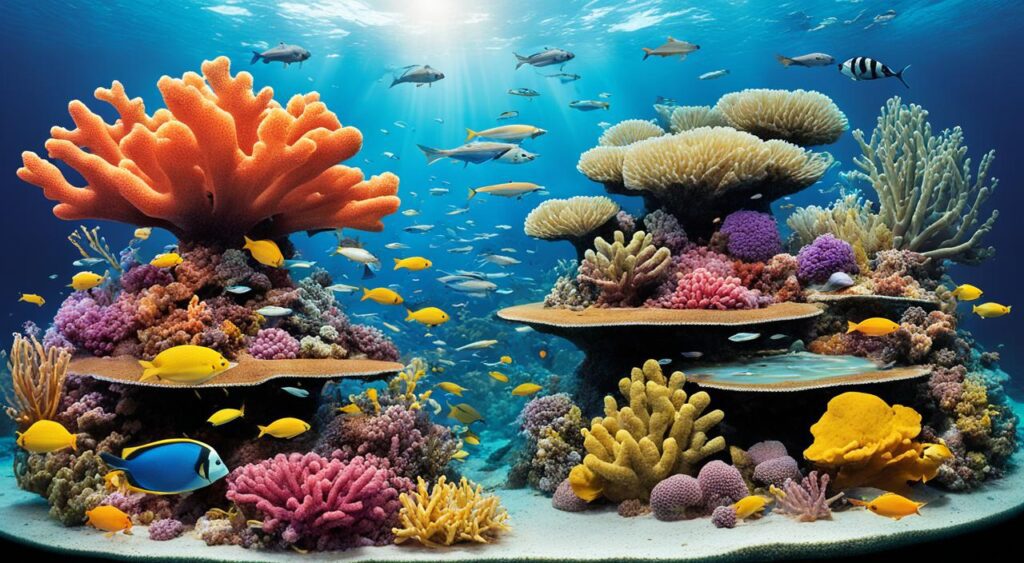
Importance of Biological Filtration
Biological filtration is a crucial aspect of the nitrogen cycle in aquariums. It involves the growth of beneficial bacteria vital in converting harmful nitrogen compounds into safer forms. Contrary to popular belief, the size or quantity of filters alone cannot increase the amount of bacteria in the aquarium.
Beneficial bacteria thrive in filters and on various surfaces within the aquarium, including gravel, glass walls, and decorations. These bacteria colonize these surfaces and provide additional areas for biological filtration.
Another way to enhance biological filtration is by adding more aquarium plants. Aquarium plants consume ammonia and nitrates, effectively contributing to removing these nitrogen compounds from the water.
To maintain a healthy nitrogen cycle, ensuring sufficient biological filtration capacity is crucial to handle the nitrogen compounds produced by fish waste. Regular water changes are essential as they help remove accumulated nitrates and replenish the water with fresh nutrients.
Overall, the combination of beneficial bacteria growth, adequate surface area for colonization, the presence of aquarium plants, and regular water changes all contribute to the efficiency of biological filtration in maintaining a stable and healthy nitrogen cycle.
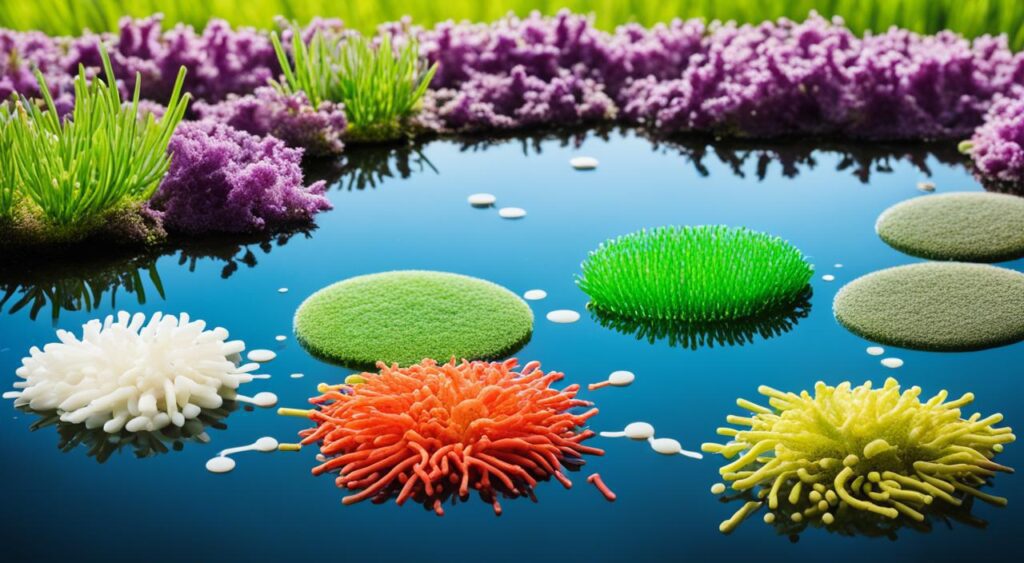
Comparison of Biological Filtration Components
| Biological Filtration Component | Function |
|---|---|
| Beneficial Bacteria | Convert ammonia and nitrites into less toxic nitrates |
| Aquarium Plants | Consumes ammonia and nitrates for growth |
| Surface Area (Gravel, Glass Walls, Decorations) | Provides additional colonization space for beneficial bacteria |
| Regular Water Changes | Removes accumulated nitrates and replenishes with fresh water |
Duration of the Nitrogen Cycle
The duration of the nitrogen cycle in an aquarium can vary, ranging from a few weeks to several months. The length of time it takes for the cycle to establish depends on several factors, such as the presence of live nitrifying bacteria, filter media from established tanks, and live plants that promote bacteria growth.
To expedite the nitrogen cycle, introducing live nitrifying bacteria can significantly speed up the establishment of beneficial bacteria populations in the aquarium. These bacteria convert harmful nitrogen compounds like ammonia and nitrites into safer forms like nitrates.
Another way to accelerate the cycling process is using an established tank’s filter media. The filter media contains beneficial bacteria that can quickly colonize the new aquarium, jumpstarting the nitrogen cycle.
Live plants can also aid in expediting the cycling process. Some live plants come with beneficial bacteria that contribute to bacteria growth and conversion of nitrogen compounds. The plants’ root systems provide additional surface area for bacteria colonization, enhancing the overall efficiency of the nitrogen cycle.
It is essential to note that a “cycled” aquarium doesn’t necessarily mean it can handle a sudden increase in fish waste. Considering the fish population in the tank, the amount of beneficial bacteria present should be adequate to convert all the waste produced into safe nitrates. Monitoring water parameters and bacteria growth is crucial to maintaining a healthy nitrogen cycle.
Overall, while the duration of the nitrogen cycle can vary, incorporating live nitrifying bacteria, used filter media, and live plants can expedite the process, ensuring a well-established and efficient nitrogen cycle in the aquarium.
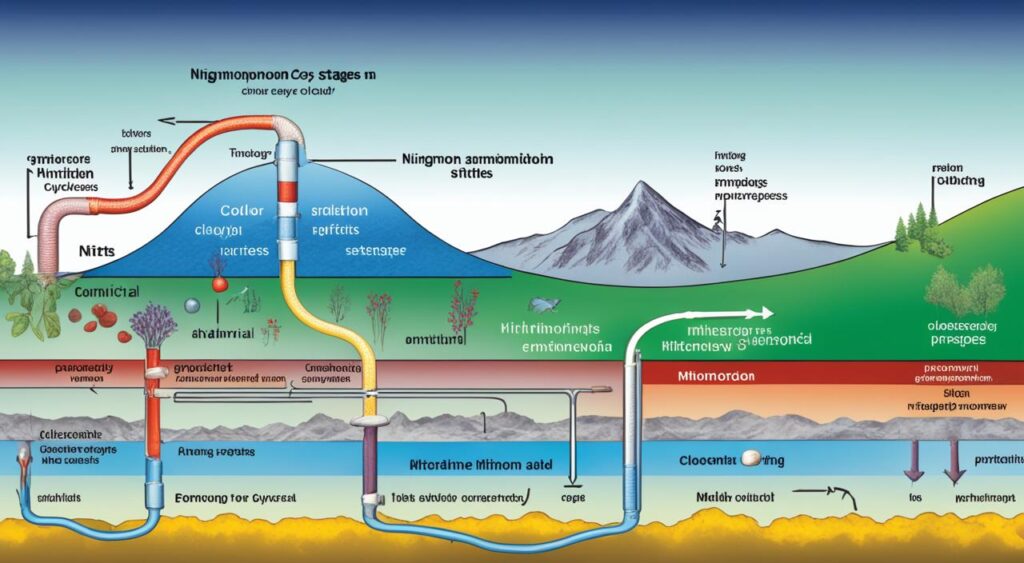
Gradual Introduction of Fish and Corals
Now that the nitrogen cycle in your aquarium is complete and the tank is safe for its inhabitants, it’s time to introduce fish and corals into their new home. However, it is crucial to approach this process gradually to avoid disturbing the delicate balance of the nitrogen cycle.
When adding fish and corals, starting with a few specimens at a time is recommended, and a 1-2 week interval is allowed before introducing more. By doing so, you maintain the stability of the nitrogen cycle and avoid overwhelming the beneficial bacteria that play a vital role in keeping the water parameters in check.
A sudden addition of a large number of fish can disturb the nitrogen cycle, as the increased waste production may surpass the capacity of the beneficial bacteria to convert it into safe nitrates. This imbalance can compromise the water quality and harm the fish and corals.
To ensure the well-being of your aquatic environment, it is best to take a gradual approach when introducing new fish and corals. By doing this, you allow the beneficial bacteria to gradually adjust to the increased waste production, maintaining the stability of the nitrogen cycle and promoting a healthy ecosystem for your aquatic pets to thrive.
FAQ
What is the nitrogen cycle?
The nitrogen cycle is a vital ecological process that describes how nature creates food, fish consume the food and produce waste, and microorganisms break down the waste into usable forms.
How does the nitrogen cycle work in aquariums?
In aquariums, the nitrogen cycle refers to the conversion of fish waste into toxic nitrogen compounds like ammonia, nitrites, and nitrates. Beneficial bacteria and plants play a crucial role in consuming these compounds, ensuring the well-being of fish.
Why is the nitrogen cycle important in aquariums?
The nitrogen cycle is of utmost importance for the health of the fish in an aquarium. High levels of ammonia, nitrites, and nitrates can be harmful to fish. The nitrogen cycle ensures that these compounds are converted into less toxic forms, keeping the aquarium ecosystem balanced.
How does the nitrogen cycle work in reef tanks?
In reef tanks, the nitrogen cycle is crucial for the well-being of corals and fish. Ammonia and nitrites are highly toxic to marine organisms, which is why it is necessary to establish the nitrogen cycle before adding corals and fish to the tank.
Why is biological filtration important in the nitrogen cycle?
Biological filtration, which involves the growth of beneficial bacteria, plays a crucial role in the nitrogen cycle. These bacteria consume toxic nitrogen compounds and convert them into less harmful forms, maintaining a healthy environment for fish and other organisms.
How long does the nitrogen cycle take in an aquarium?
The duration of the nitrogen cycle in an aquarium can vary, ranging from a few weeks to months. However, there are ways to speed up the process, such as adding live nitrifying bacteria or using used filter media from an established tank.
How should fish and corals be introduced during the nitrogen cycle?
It is important to introduce fish and corals gradually during the nitrogen cycle to avoid disturbing the process. Adding a few fish and corals at a time and allowing a 1-2 week interval before introducing more can help maintain the stability of the cycle.

